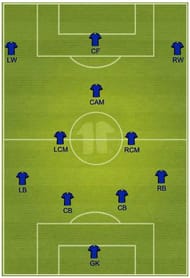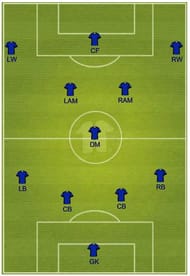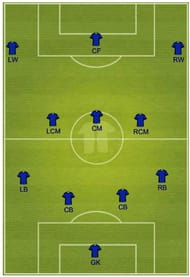
Jose Mourinho during the friendly match between Chelsea FC and the Singha Thailand All-Star XI at Rajamangala Stadium on July 17, 2013 in Bangkok, Thailand. (Getty Images)
Part one of the article explained the reasons to ditch 4-2-3-1 in favor of 4-3-3. So how can the latter be more effective? One factor that stands out is the squad’s flexibility.
The 4-3-3 ensures each player is capable of playing in more positions than the 4-2-3-1, while the central midfield position is the most unpredictable area of the formation, which if played to perfection, can leave the opponents chasing shadows.
Here the variants of 4-3-3 are explained first:
This is one variant of 4-3-3 where two of the three central midfielders sit back, while the other advances into the hole behind the striker. The functions of the two holding players are similar to the double pivot of the 4-2-3-1.
The CAM (central attacking midfielder) can roam free anywhere in the advanced areas, though his position is designated as above. This position serves as a link between the holding duo in the centre and the entire forward line.
In addition to that, the CAM can swap positions with the wide forwards at will, provided they are comfortable in each other’s position. As you may have already guessed, this is more of a defence-oriented formation.
Here there is one defence-minded player in the middle (this position is often called the ‘Claude Makelele position’). He combines the functions of both players in the double pivot – breaking up play and keeping possession ticking.
While this seems a bit risky on the defensive side of things, it works wonders in attack. There are two advanced midfielders to link with the forward line rather than one. While the CAM in the holding variant is more prone to link with the centre forward, the presence of the LAM and the RAM provides an alternative route.
The LAM can either connect with the LW or RW, or supply a short diagonal ball to the forward. This increases the unpredictability about which direction the duo is likely to play the ball. Thus the forward line is well supplied and supported.
As in the previous case, there is scope for exchanging positions. This time, that is even more dangerous as up to five players can rotate in the advanced positions (assuming the centre forward does not contribute to the mix and match). This formation comes across as a very attack-minded one.
This one seems more suited to the long ball game. The holding position(s) from the previous variants are pushed a bit further up the pitch, while the attacking midfielder is withdrawn by an equal extent. Thus, all three midfielders are side-by-side.
They may either push forward together as a unit (this becomes a hyper attack-minded shape, which leaves a gaping hole in the middle) or choose to track back together (this time, as a stubborn three-man wall in front of the defence, which definitely reduces the probability of conceding, while leaving the forward line short of supply).
In the more defence-oriented case, the only way to supply the forward line would be through long balls.
Now, let’s apply the above variants to the team.
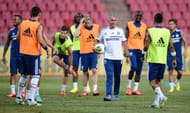
Jose Mourinho during a Chelsea FC training session at Rajamangala Stadium on July 16, 2013 in Bangkok, Thailand. (Getty Images)
On paper, all the three variants are the same, coming under a label ’4-3-3′. Jose Mourinho’s options for the midfield and forward line combined, is rather vast.
He has the likes of Eden Hazard, Juan Mata, Oscar, Kevin De Bruyne, Fernando Torres, Romelu Lukaku, Demba Ba, Lucas Piazon, Victor Moses, Andre Schurrle, Josh McEachran, Frank Lampard, Ramires, Marco van Ginkel, Nathan Ake, John Obi Mikel, Mikel Essien and David Luiz; 18 in all (19 if Chelsea actually manage to sign Manchester United’s Wayne Rooney).
This is way too much depth just to fill just six slots. Let us consider each player individually and examine their probable positions.
Hazard and Mata, who are extremely alike, are capable of playing anywhere as long as it is in an attacking capacity. On the left wing, Hazard can be a threat, cutting in on his favoured right foot. Likewise, Mata can cut inside from the right to use his left.
Though both aren’t true wingers who hug the touchline, they can affect the opposition fullback’s marking with their movement. Another option for both would be to play behind the striker.
Assume that the shape is a holding 4-3-3 and De Bruyne is on the pitch. We know that De Bruyne likes to play wide or just behind the striker. The same goes for Hazard, and to a lesser extent, Mata. Now, De Bruyne swaps with either Hazard on the left, or Mata on the right.
This would put one of Hazard and Mata into their favourite position behind the forward, while De Bruyne goes out wide. Depending on who he is swapping positions with, KDB’s role changes either to that of a classic winger or an inverted winger.
This is how it could look:
Add Lucas Piazon to the mix as well, performing the same role as De Bruyne. Oscar has also been deployed in wide positions in the past (by Rafa Benitez) to an average level of success. Though it is not his most comfortable position, he is an option nonetheless.
The above discussion takes care of Hazard, Mata, De Bruyne, Piazon, and to a certain extent, Oscar.
Moving on to the next set, keeping the same formation in mind, let us turn our attention to another group of players who are capable of playing wide or as the central striker: Schurrle, Moses, Torres and Lukaku.
Lukaku has played on the right sometimes for West Brom with strong results (in particular, one of his goals against Reading came from there). If played wide, he offers direct running and a devastating burst of pace (a better version of Moses one might say). This is just another possibility, since Lukaku is at his best leading the line rather than supporting it from wide.
While Lukaku and Moses are options on the right, Torres and Schurrle are possibilities to drift to the left. Torres, primarily a centre forward, has shown that he can deliver a good number of assists as well. In some of his substitute appearances over the past couple of years, this slight change of role has helped him increase his assist count.
Schurrle still remains a mystery. But he is equally happy to play as the centre forward or as the left forward. Amidst this mix, Ba remains the only static player, who cannot play anywhere other than the central position (he was forced out wide when Cisse arrived at Newcastle, which resulted in him becoming anonymous in most games).
Torres, Schurrle, Moses, Lukaku, and Ba have been taken care of here. Add some wide players like De Bruyne, Hazard, and Mata to the mix, and think of the possibilities. We have the chance of permuting eight players into three positions, which results in a huge number of possible arrangements.
Now, consider the Brazilian duo of Oscar and Ramires. Ramires, like Oscar, can play wide, but would prefer to play centrally. Oscar comes across as the most flexible player in the squad here, as he can play the deep-lying playmaker role in addition to playing further up and wide (he plays this role for Brazil).
Thus we have Ramires and Oscar for wide areas and in the centre, with Mikel, Essien and Ake as the true holding players.
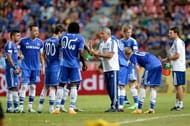
Talking Tactics: Jose Mourinho during the between Chelsea FC and the Singha Thailand All-Star XI Rajamangala Stadium on July 17, 2013 in Bangkok, Thailand. (Getty Images)
The next set includes van Ginkel, Lampard, Luiz, and McEachran. Luiz is a real conundrum here: is he a centre back? Yes. But can he just remain stationary in central midfield like Mikel? No. Does he time his runs like Lampard? No. But he has an equal vision compared to Lampard in picking out a pass. Luiz is a mix of everything – Ramires, Mikel and Lampard.
McEachran meanwhile, like Oscar, would prefer to play as a central midfielder of any role. We have not seen much of van Ginkel yet, so adding him to the mix would make things even more of a mystery.
The attacking 4-3-3 and the flat 4-3-3 are yet to be looked into. For starters, the attacking 4-3-3 makes better use of the talents of Lampard, Oscar, Hazard, Mata, Piazon and De Bruyne, while more defence-minded players like Mikel, Luiz, or Ake are sure to thrive in the flat one.
The 4-3-3 clinches it. With three variants, there is more scope to change the midfield mid-game. The squad right now has too many players capable of playing too many sets of positions.
One set consists of the centre forward, who can drift wide (and vice versa), the attacking midfielder, who likes to go wide sometimes (and vice versa), the forward who likes to drop into the CAM’s area, followed by the central midfielders capable of playing wide when required, and lastly, the central midfielders who can both hold defence and support the striker.
Another set comes to mind – holding players who can fill in as defenders, namely Luiz and Essien. The probable signing of De Rossi, which had become so crucial according to Part 1 of this article, is not at all required now. Money saved!
In the case of the 4-2-3-1, the scope for this amount of flexibility is limited. The wide player in the ’3′ here is more withdrawn than the wide forward in the 4-3-3. This would classify him as a midfielder rather than a striker, something that players like Torres and Lukaku would not enjoy.
The one forward is static, with almost no chance of changing to another role. The trio has to be chosen from a roster of up to 10 players; a similar argument for the double pivot. Thus, the 4-2-3-1 requires team selection by layers – two in the double pivot, and three behind the striker.
The 4-3-3 meanwhile gets rid of this layer-wise selection because all that the manager has to do here is choose five players from 18, ask two of them to start wide to support one static forward and three of them to scroll through the variants in midfield. The 4-2-3-1 does not have many significant variants, which the 4-3-3 does.
With this apparent depth for every position (‘apparent’ because players’ roles may intersect; that is, if a player is listed as a candidate for one position, he may also be found in another list of positions), squad depth is utilised to its fullest.
The opponent will have a really hard time figuring out the starting XI, and once the team is put out, the variant of the formation becomes a question for the opposition. The formation can even be rotated between its three variants mid-game, which will make the team even more unpredictable.
This would put any man-marking assignments to shame (as it would be extremely difficult to cope if the player who he is supposed to mark starts wide, then suddenly moves into a defensive midfield position).
Man-marking compromises the opponents’ shape. For each man-marking assignment of the opponents, one position is left free to exploit. Once the man-marker is negated, the opponents are effectively reduced to ten men. Technically, the opponents are outnumbered, and the space left by the marker can be exploited by a quick transition.
The 4-2-3-1 has had its day at Chelsea, and should make way for a more fluid, dynamic, extremely dangerous, and ever changing 4-3-3. This is the way forward as it makes maximum use of each and every player’s utility. Let’s hope the Special One thinks the same way and implements it to devastating success.
You can read part one here: Mourinho and the Chelsea formation debate – Part 1
